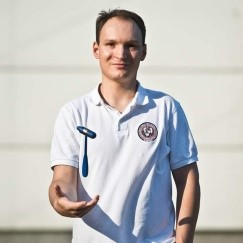The primary research focus of the group is social cognition in patients with various neurological diseases. The largest portion of the research is dedicated to patients with epilepsy. Additionally, this group focuses on patients with temporal lobe dysfunction, such as those with neurodegenerative diseases (particularly Alzheimer's disease), vascular conditions (e.g., CADASIL), and demyelinating disorders of the brain.
Social cognition is a set of mental skills that underlie the ability to engage in social interactions. This complex concept encompasses a range of functions, such as emotion recognition from facial expressions or vocal intonation (prosody), empathy, and Theory of Mind (ToM). ToM is a key component of social cognition and refers to the ability to assess the mental state of others by evaluating and predicting their behavior and emotions. It has both cognitive and affective components: the cognitive component focuses on understanding and predicting the actions of others, while the affective aspect involves perceiving others' emotions and empathizing with them (1-3). Social cognition impairment is well-documented in patients with focal epilepsy, such as temporal or frontal lobe epilepsy.
This working group is part of the Epilepsy Research Centre Prague (EpiReC), which focuses on understanding the neuronal dynamics of cognitive functions in the human brain in patients with various types of epilepsy. To achieve this, we utilize unique recordings of brain activity captured through intracerebral electrodes placed directly in the human brain. This approach offers a unique opportunity to measure the activity of neuronal populations near the electrodes. Our goal is to develop a comprehensive battery of cognitive tests that would not only assess potential deficits in patients but also explore the dynamics of neural networks, gain insights into the brain activity underlying different cognitive functions, and ultimately predict or even prevent potential cognitive deficits in patients with epilepsy after surgery.
Test Methods:
- MUSE Meditation Headband: This non-invasive device monitors EEG activity through five electrodes and provides real-time feedback via a smartphone app, indicating whether the user is indeed meditating or relaxing. This allows for controlled meditation. The MUSE device offers the advantage of uniform meditation exercises and feedback, ensuring an objective evaluation of meditation across participants. MUSE has been validated as a controlled meditation tool in clinical research (4).
- Ambiguous Intentions Hostility Questionnaire (AIHQ): Developed by Combs et al., this test is used in clinical settings to assess hostile attribution bias in individuals with schizophrenia. It measures three types of scores: hostility bias, aggression bias, and blame score. Participants are presented with 15 negative scenarios, with five each being intentional, accidental, or ambiguous. A higher score indicates a greater level of attributional bias (5).
- COSIMO (Cognition of Social Interaction in Movies): COSIMO is a time-efficient, user-friendly screening tool designed to measure the quality of social cognition. It consists of 25 short videos portraying dyadic interactions. After watching each video, participants choose one of three emotions that best describe the interaction. The result is the number of correct answers. Web-based interface makes COSIMO easily accessible, allowing it to be implemented in daily clinical practice.
- Intracranial EEG: This unique method records brain activity using electrodes implanted directly in the brain. Due to its invasiveness, intracranial EEG is conducted only in epilepsy patients undergoing pre-surgical evaluation, with electrodes placed in designated brain areas. We perform various cognitive tasks evaluating attention emotion recognition, numerical cognition, working memory, motion encoding, and visual information processing. We focus not only on the timing of activations within different brain networks but also on their interactions with each other.

(A) An intracranial electrode setup. (B) A patient undergoing a cognitive test focused on motion representation within the cerebral cortex. (C) An example from a cognitive test involving a simple computer game that simulates driving a car. (D) Brain activity observed during upper limb movements, specifically while turning the steering wheel.
1) Le Bouc R, Lenfant P, Delbeuck X, Ravasi L, Lebert F, Semah F, Pasquier F. My belief or yours? Differential theory of mind deficits in frontotemporal dementia and Alzheimer's disease. Brain. 2012 Oct;135(Pt 10):3026-38. doi: 10.1093/brain/aws237. PMID: 23065791.
2) Baksh RA, Abrahams S, Bertlich M, Cameron R, Jany S, Dorrian T, Baron-Cohen S, Allison C, Smith P, MacPherson SE, Auyeung B. Social cognition in adults with autism spectrum disorders: Validation of the Edinburgh Social Cognition Test (ESCoT). Clin Neuropsychol. 2021 Oct;35(7):1275-1293. doi: 10.1080/13854046.2020.1737236. Epub 2020 Mar 19. PMID: 32189564.
3) Stewart E, Catroppa C, Lah S. Theory of Mind in Patients with Epilepsy: a Systematic Review and Meta-analysis. Neuropsychol Rev. 2016 Mar;26(1):3-24. doi: 10.1007/s11065-015-9313-x. Epub 2016 Jan 21. PMID: 26797753.
4) Ratti, E., Waninger, S., Berka, C., Ruffini, G., & Verma, A. (2017). Comparison of medical and consumer wireless EEG systems for use in clinical trials. Frontiers in Human Neuroscience, 11. https://doi.org/10.3389/fnhum.2017.00398
5) Combs DR, Penn DL, Wicher M, Waldheter E (2007) The Ambiguous Intentions Hostility Questionnaire (AIHQ): A new measure for evaluating hostile social-cognitive biases in paranoia. Cogn Neuropsychiatry 12:128–143. https://doi.org/10.1080/13546800600787854
6) Hammer J, Kajsova M, Kalina A, Krysl D, Fabera P, Kudr M, ... & Marusic P (2024). Antagonistic behavior of brain networks mediated by low-frequency oscillations: electrophysiological dynamics during internal–external attention switching. Communications Biology, 7(1), 1105.
Academic staff
 MUDr. Viktória Pytelová
MUDr. Viktória Pytelová
MUDr. Martin Šimčík
Mgr. Jakub Žalud



